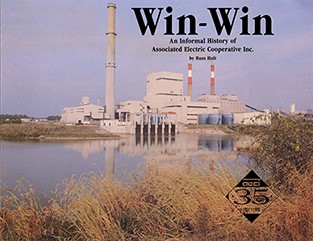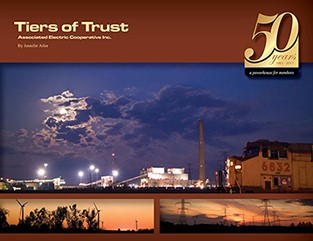Find out more about how this website uses cookies to enhance your browsing experience.
Celebrating 60 years of serving co-ops

Nation's top-rated G&T grows from cash-starved co-op
Since its formation in 1961 by six generation and transmission cooperatives, Associated Electric Cooperative has grown under the leadership of its member-directed board and management. Today, Associated Electric has a strong financial position, diverse power supply, integrated transmission system and is positioned as one of the lowest-cost generation and transmission cooperatives in the nation.
Throughout the years of change and challenge, Associated Electric has never lost focus of the reason it was formed: to provide an economical and reliable power supply and support services to its members. This historical timeline shows development of Associated Electric:
Once upon a time, electric service was a luxury enjoyed only in cities, where the concentration of people was high enough to make it economical. Meanwhile, in sparsely populated rural areas where electrification wasn't profitable, people were left in the dark -- and left behind.
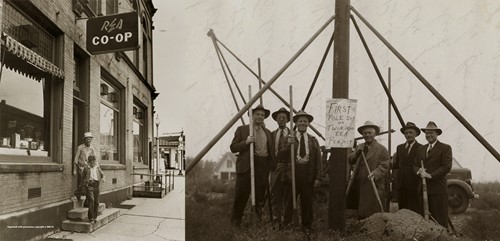
Finally, the federal government realized that if rural America were ever to be electrified, the country as a whole would have to lend a helping hand. So in 1935, Franklin Delano Roosevelt signed an executive order creating the Rural Electrification Administration. A year later Congress gave the agency the money and power needed to promote rural electrification by providing low-cost loans to build transmission and generation facilities.
Rural cooperatives formed rapidly to take advantage of the favorable financing. Farm by farm, village by village, the lights went on across rural Missouri and rural America. And as electrical needs grew, the REA continued to provide low-cost financing. Eventually, Associated's major generation facilities, built primarily during the 1960s and 1970s, were financed with help from the REA.
The electrification of rural America often is described as the single most dramatic event to touch the daily lives of this country's farming families. It helped make this nation's agriculture industry the most productive in the world and enabled the rural economy to grow in even more unexpected ways.
As late as 1961, the year Associated was formed, a large majority of its electric consumers were involved in farming. Today, about 10 percent claim to receive their principal income from agriculture. Meanwhile, business and industrial customers have grown to more than 30 percent of member energy sales, although they make up only 8 percent of cooperative members.
In addition, Associated is an active member of the Association of Missouri Electric Cooperatives, the Iowa Association of Electric Cooperatives and the Oklahoma Association of Electric Cooperatives, which assist rural electric cooperatives and promote growth and development of rural America.
Learn more about electric cooperatives at www.electric.coop.
In 1935, 6.4 percent of the farms in Missouri had electricity – more than many other states in the mid-South. Yet, more than 90 percent of farms in France, Germany, Holland and Switzerland were electrified during the same period. Rural Americans simply didn't have the economic clout to obtain the one commodity that, more than anything else, could increase production and improve the quality of their lives – electricity.
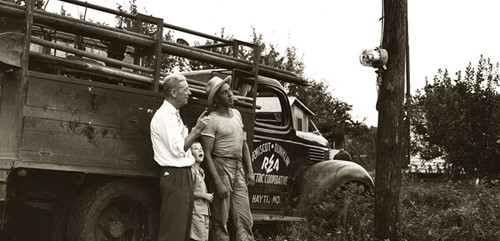
1935 - President Franklin D. Roosevelt signs an executive order creating Rural Electrification Administration (REA).
1936 - Congress passes Rural Electrification Act of 1936.
1937 - Association of Missouri Electric Cooperatives (AMEC), originally called The Missouri State Rural Electrification Association, forms on Feb. 11, 1937.
1941 - KAMO Power forms. Representatives of 26 cooperatives create Sho-Me Power Electric Cooperative.
1943 - Southwestern Power Administration (SWPA) is created.
1948 - M&A Electric Power Cooperative incorporates. Northeast Missouri Electric Power Cooperative forms.
1949 - Central Electric Power Cooperative forms. NW Electric Power Cooperative Inc. forms.
1952 - M&A Electric Power Cooperative begins operations with the building of 10-megawatt Green Forest Power Plant.
The 1960s was a decade of birth, establishment and growth for Associated Electric as it strove to meet the need for which it was created.
It obtained success early. In 1964, Associated Electric President John Buck said its first full year of operation “shows that through Associated the rural electric cooperatives of Missouri now have an abundant supply of low-cost wholesale electricity. In 1961, not so long ago, this was not true.”

1961, February 6 - Fifteen incorporators sign articles of incorporation to create Associated Electric Cooperative Inc. Two days later, attorney Gene Andereck travels to the statehouse to file articles of incorporation and obtain a charter for the cooperative.
1962, March 28 - During a ceremony in Springfield, draft contracts between the soon-to-be Associated Electric and three western Missouri investor-owned utilities are signed.
1962, May 28 - Neil L. Adams is hired as Associated Electric’s first general manager (serving in that position until June 1971).
1962, July 25 - The Department of the Interior grants final approval to form Associated Electric Cooperative Inc.
1962, August 1 - After approval from the REA and the Department of the Interior, Associated Electric officially begins operations.
1965 - Associated Electric builds its first transmission line, a 1.5-mile tie line between M&A Electric Power Cooperative and Union Electric. This is the first of many interconnections with other utilities for Associated Electric.
1966 - Associated Electric’s first big power plant, Thomas Hill Unit 1 at 180 megawatts, begins operating.
1968 - Associated Electric, the city of New Madrid and Noranda Aluminum Inc. work together to clinch a deal that would bring the aluminum smelter to New Madrid, Mo.
1969 - Thomas Hill Unit 2 goes on line, adding 303 MW for members’ energy needs.
“The decade of the ’70s was a most difficult period for the electric utility industry,” General Manager Gerry Diddle wrote in the 1979 Annual Report. “It was replete with a multitude of new and changing government regulations, increasing inflation and high interest costs.”
It was also a time of tremendous growth in the use of electric energy by member systems. Kilowatt-hour sales increased 236 percent and kilowatt-hour demand increased 220 percent, Diddle said.
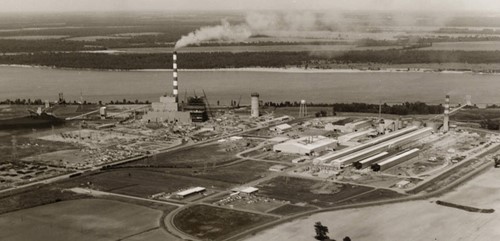
1970 - Associated Electric begins serving the largest single industrial load in the state, Noranda Aluminum Inc., which it serves for the next 33 years.
1972 - New Madrid Power Plant’s first unit of 600 megawatts goes on line.
1973 - Gerald F. Diddle becomes Associated’s general manager (serving until February 1992).
1974 - Associated Electric agrees to become a partner in the Black Fox Nuclear Project, which was later terminated.
1976 - Board authorizes construction of Thomas Hill Unit 3.
1977, June 1 - New Madrid Power Plant Unit 2 goes on line.
1978 - Associated Electric enters the coal business, buying Bee Veer and Prairie Hill mines near Thomas Hill Power Plant from the Peabody Coal Co., and begins operations in 1980.
1979 - Associated Electric negotiates with REA for the largest loan guarantee in the history of the rural electrification program: $1.4 billion to pay for Thomas Hill Unit 3; Black Fox Nuclear Project; new mining operations; and to offset double-digit interest rates in the late 1970s.
Expansion at Thomas Hill Energy Center dominated the scene during the 1980s as Associated Electric brought on line its fifth generating unit and modernized a newly purchased coal mine.
Construction efforts during 1980 were the largest in Associated Electric's operating history. Total utility plant (fixed assets including the power plants, transmission facilities and Headquarters, but excluding the mine) increased $260 million and represented a greater investment in new facilities than Associated Electric made in its first 14 years of operating history. The majority of those funds were expended in construction of the 670-megawatt Thomas Hill Unit 3. The final cost of the unit was estimated at $490 million.
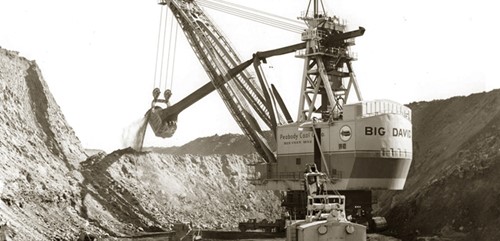
1980, January - The Missouri Joint Municipal Electric Utility Commission, commonly called the Municipal Pooling Commission, begins operating with the signing of a joint contract by six charter members.
1982 - Thomas Hill Unit 3, a 670 megawatts unit, goes on line. Associated Electric terminates the Black Fox Nuclear Project following the incident at Three Mile Island nuclear station that changes the feasibility of building a nuclear plant in the United States.
1989 - Associated Electric forms its Clean Air Act contingency fund to help pay for changes at its power plants required by the 1990 Clean Air Act Amendments. House Bill 813 allows private power companies and local cooperatives to adjust their service territory boundaries.
Competition became the watchword of the 1990s as it pervaded almost all American industries. Bankers to bakers found “downsizing” or “restructuring” a means to become more efficient and competitive.
The electric utility industry was no different. News of budget cuts, layoffs and mergers dominated industry reports. Even rural electric cooperatives, once insulated from such pressures, felt the threat of competition. Strengthening its competitive position became a priority for Associated Electric Cooperative.
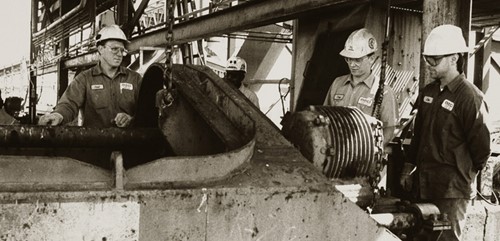
1991 - James J. Jura becomes general manager.
1992 - Following the Clean Air Act Amendments of 1990, cooperatives work with state authorities to enact Clean Air Act compliance legislation, effective in 1992.
1992, October - The Comprehensive National Energy Policy Act is approved.
1993, February - Associated Electric exits the coal business, closing its mines.
1995, December - The conversion to low-sulfur coal at both Thomas Hill and New Madrid power plants is completed, reducing emissions of sulfur dioxide 90 percent and allowing Associated Electric to implement an average overall rate reduction of 17 percent. Associated Electric’s rates for wholesale electricity rank as second lowest in the nation.
1996, October - Associated Electric announces a partnership with PanEnergy (later purchased by Duke Energy) to construct a 250-MW, gas-based power generation facility known as St. Francis Power Plant. Construction begins in fall 1997.
1997, November - KAMO Power selects Associated Electric as the power supplier for its nine electric cooperatives in northeast Oklahoma. Associated Electric already generates power for KAMO’s eight cooperatives in Missouri.
1999 - The first units of a 1,633-megawatts construction phase of gas-based generation come on line to meet members’ peak demand needs. Intermediate and peaking power plants that begin operations in the next four years are: Essex, 107 MW, and Nodaway, 182 MW, power plants, June 1999; 245-MW St. Francis Unit 1, September 1999; 522-MW combined-cycle Chouteau Power Plant, June 2000; St. Francis Unit 2, 256 MW, March 2001; and 321-MW Holden Power Plant, May 2002.
Renewables became a key word in Associated Electric Cooperative’s generation resource mix during the millennial decade. Associated Electric was named “2006 Wind Co-op of the Year” for helping make Missouri’s first utility-scale wind farms a reality. New environmental regulations also permeated the decade. Associated Electric built with compliance in mind, spending more than $1.1 billion since 1994 to improve air quality.
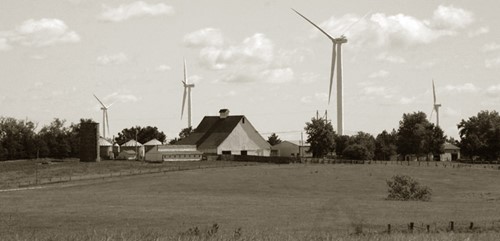
2000, February - Selective catalytic reduction equipment, designed to reduce emissions of nitrogen oxides by about 93 percent, on New Madrid Unit 2 becomes operational.
2002, January - Selective catalytic reduction equipment on New Madrid Unit 1 becomes operational, making New Madrid one of the cleanest coal-based plants in the country with cyclone burners.
2003, May 31 - Associated Electric’s contract ends with Noranda Aluminum. Noranda chooses not to renew its power supply contract with Associated Electric, ending a mutually beneficial relationship of more than 30 years.
2003, December - Associated Electric’s board of directors approves a rate plan after engaging in a yearlong process of informing and listening to member systems. The plan includes a wholesale power supply rate increase in 2006 – Associated’s first wholesale rate increase in 20 years – that will help the cooperative meet a projected $1.7 billion in capital costs for new generation and environmental controls on existing coal-based generation. More rate increases are projected.
2004, December - Associated Electric completes mine amortization of $342 million in costs 11 years ahead of schedule – further strengthening the cooperative’s competitive position. Associated Electric closed its Missouri mine in 1993 and converted its coal-based units to burn low-sulfur coal in 1994. This conversion allowed the cooperative to reduce sulfur dioxide emissions and comply with the 1990 Amendments to the Clean Air Act.
2005, April 1 - Associated Electric announces it is proceeding with plans to build a coal-based generating plant to meet members’ growing energy needs. Carroll County is the proposed site, along with Holt County as an alternative location.
2005, Aug. 15 - Associated Electric purchases 580-megawatt, combined-cycle natural gas-based power plant in Dell, Ark., to meet members’ growing energy needs. Construction begins in spring 2006 to finish the plant, which is 65 percent complete. It begins commercial operation in 2007.
2006, January - In January, Associated Electric, Wind Capital Group and John Deere Wind Energy announce plans to construct Missouri’s first utility-scale wind farm: the 57-megawatt Bluegrass Ridge Wind Farm near King City. On the heels of this announcement, a second and third wind farm are announced in summer and fall 2006. Associated Electric’s integrated transmission system and its long-term agreement to buy all the power produced by the three wind farms help make the farms possible.
2006, June - Associated Electric begins construction of additional environmental controls at its Thomas Hill Energy Center. To be completed by Jan. 1, 2009, installation of selective catalytic reduction equipment on all three units enable a systemwide reduction of nitrogen oxides emissions of nearly 90 percent and compliance with Clean Air Interstate Rule (CAIR).
2007, March - Praised for its bold leadership in renewable energy development in Missouri, Associated Electric is awarded “2006 Wind Co-op of the Year” by the U.S. Department of Energy in partnership with the National Rural Electric Cooperative Association and Cooperative Research Network.
2007, May 2 - Associated Electric and its Thomas Hill Energy Center receive the 2007 Kenes C. Bowling National Mine Reclamation Award in the coal category for reclamation of the Bee Veer Mine in Macon County, Mo.
2007, Sept. 17 - About 475 member-owners, state and federal legislators and other officials attend dedication of Bluegrass Ridge Wind Farm, Missouri’s first utility-scale wind farm. The project is made possible due to Associated Electric’s agreement to purchase all power produced by the wind farm for the next 20 years, its interconnected transmisson system and its alliance with John Deere Wind Energy and Wind Capital Group.
2007, Sept. 20 - U.S. Department of Interior Office of Surface Mining presents its highest award to Associated Electric for its innovative reclamation of the Bee Veer Mine in Macon County, Mo.
2008, Feb. 29 - Associated Electric’s board of directors decides to delay indefinitely plans to build a 660-MW coal plant near Norborne, Mo., in Carroll County, citing increasing costs of building such a facility and the uncertainties about carbon regulations.
2008, February and March - Cow Branch and Conception wind farms in northwest Missouri begin producing power.
2008, March 7 - Associated Electric’s “Take Control and Save” energy efficiency program debuts. The program builds on distribution cooperatives’ longtime energy efficiency efforts.
2008, March 20 - Associated Electric’s Dell Power Plant is dedicated. The 580-MW facility is a low-emissions, efficient combined-cycle gas plant used to meet members systems’ growing energy needs.
2008, December - Associated Electric completes $424 million construction project that includes installing selective catalytic reduction equipment on all three units at Thomas Hill Energy Center, enabling a 90 percent systemwide reduction of nitrogen oxides (NOx) emissions, by the Jan. 1, 2009, Clean Air Interstate Rule deadline.
2009, April 16 - Associated Electric and Wind Capital Group announce the fourth and largest wind farm in Missouri: the 150-megawatt Lost Creek project in DeKalb County. Vice President Joe Biden announces the wind farm during a visit to Jefferson City to promote the administration’s stimulus plan. Again, Associated Electric helps make the project possible by providing transmission and long-term power purchase agreement.
2009, June - Associated Electric honors retiring board president O.B. Clark for his distinguished service on its board from 1974 to 2009 and as Associated Electric’s longest-serving president, from June 1981 to June 2009.
Facing another economic downturn, which touches nearly all of its members, Associated Electric Cooperative continues to follow its five-point business strategy, seek innovative ways to reduce operational and environmental costs, fulfill challenging environmental and compliance regulations and keep electricity affordable and reliable for members.
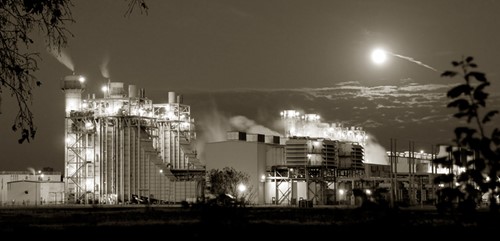
2011 - Associated Electric celebrates its 50th anniversary, highlighting the six generation and transmission cooperatives that formed Associated Electric in 1961.
2011, June - Chouteau 2, a 540-megawatt, combined-cycle natural gas unit in Pryor, Okla., goes online on schedule and under budget. Construction of the power plant began in 2009, using new, stored still-in-the-box components that were purchased by Associated Electric in 2006.
2012, December - Flat Ridge 2 Wind Farm, in Kansas, moves into full commercial operation. Associated Electric has a long-term power purchase agreement with BP Wind Energy to receive 300 MW of wind power. This brings Associated Electric’s total wind portfolio to 600 MW, an increase from 300 MW.
2015, June - The 150-megawatt Osage County wind farm in Oklahoma comes on line, bringing Associated's contracted wind energy capacity to 750 MW.
2016, May-June - AECI Board of Directors hires David J. Tudor as the cooperative's next CEO and general manager. He starts work May 16, 2016. James J. Jura, Associated's CEO and general manager since Aug. 26, 1991, retires June 3 after nearly 25 years of leading the cooperative.
As Associated Electric celebrates 50 years of successfully tackling many challenges, it looks forward as a well-positioned generation and transmission cooperative with generation capacity, financial strength and flexibility and the support of a cohesive three-tiered system.
2018, June -- Associated completes 18-month, cooperativewide process to develop Long-term Strategic Plan and presents plan and strategies to members at annual meeting.
2020, May -- 235-MW Clear Creek wind energy project comes online, bringing Associated's contracted wind energy to more than 1,000 MW.
2020, Dec. 10 -- The 236-MW White Cloud wind project in northwest Missouri is declared commercial, bringing Associated's contracted wind energy to more than 1,240 MW.
History books
Associated Electric celebrated its 50th anniversary in 2011. The book “Tiers of Trust" is a sequel to "Win-Win," the first informal history of Associated outlining its first 35 years from 1961 to 1996. "Tiers of Trust" is a continuation of that history from 1996 to 2011 and recognizes the cooperative's dedication to its members for 50 years. Select the book you want to read and enjoy!
